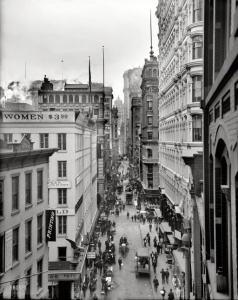Nassau Street 1905
Nassau Street runs six blocks in lower Manhattan near Wall Street. As a street and as a philatelic institution it is a microcosm of how stamp collecting and dealing has changed. Stamp collecting began to be an extremely popular mainstream hobby beginning about 1900 and stamp dealers opened their doors as stand alone shops and not part of larger hobby retailers. In most cities, retailers congregate near each other as smaller stores open near larger, successful ones hoping to flake off some of their trade. This is still seen in the jewelry districts in most cities. The same is true with the stamp trade and Nassau Street in lower Manhattan, with its low rents, proximity to the lower East Side (where many immigrant stamp dealers lived), and central location for New York’s commercial and legal industries began to attract large numbers of stamp dealers. These were the days before the Internet and before the widespread acceptance of mail order. Buyers, and not just stamp buyers, wanted to see before they purchased. Today, nearly all stamp trading is done where buyers never see the actual item until it is delivered. There is very little traditional retail stamp business now, as there are virtually no stamp shops; and stamp shows have declined in importance (It speaks well of the trust that the philatelic trade has earned that so much business can be done without the buyer first touching the item. Collectors need to know that dealers have accurately graded the item and stand behind their sales with a complete money back guarantee).
Nassau Street was the center of the American stamp trade, and by the mid-1930s, there were over one hundred stamp shops crowding its six blocks. Some were street front retailers, but most dealers there had small offices in the high-rise office buildings on the street. Tunnelling between the offices were hundreds of “satcheleteers” who made their living buying items in one office and selling them in another. Collectors from around the country would plan their holidays in New York so they could go to Nassau Street. Collecting wasn’t as easy then as it is today. Today, any evening, any collector can have his choice of hundreds of thousands of stamps online. In 1930, most collectors had to go to New York to get a decent selection, and go they did. My grandfather, Earl, told me about his trips to Nassau Street in the 1930s. They were the highlight of his month. He had opened his stamp shop in Philadelphia and would go to Nassau Street to unload surplus inventory and buy stamps for his customer want lists. World War II hurt Nassau Street. Travel was difficult, and the rise of stamp publications such as Linn’s made mail order purchasing easy. By 1970, the rising rents in lower Manhattan had all but driven the stamp dealers away, and the last time I went I didn’t see a single street front stamp store on Nassau Street. We are apt to see all economic transformations through the glass of our most recent experiences. But, it was not the Internet though that killed Nassau Street. It was mail order stamp dealing.


